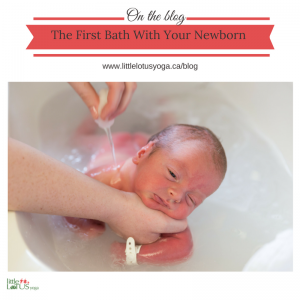Baby’s first bath is such a special moment for parents. It is an intimate bonding experience, and most babies really enjoy the warm water. Baths recreate the womb for newborns, reintroducing them to the warm and wet environment from which they were born.

In most hospitals, postpartum wards will give baby their first bath within 24 hours after the birth. This becomes a teaching opportunity for nurses, who will show new parents the proper way to bathe a newborn.
In recent years however, many parents have advocated to delay baby’s first bath. By opting out of the hospital experience and choosing to give their newborn a bath at home, parents are taking this intimate experience back into their own hands.
Reasons to delay the first bath
Other than a desire to do the first bath at home, would there be other reasons why parents choose to opt out?
When babies are born, their skin is covered in a white creamy substance called vernix. This substance helps to protect baby’s skin in the womb, and has been shown to contain lots of healthy bacteria. If washed off (especially with harsh soaps,) baby’s skin can become dry and irritated.
Vernix is best left on the skin, and rubbed in like a cream. Some babies are born with tons of vernix, so wiping some of it away with a warm towel at birth is not a problem.
As well, babies born vaginally receive a whole host of healthy microbes (bacteria) from the mother as they move through the birth canal. Baby’s gut is seeded with these microbes, along with any bacteria they come into contact with right outside the womb. Researchers have linked a lack of a healthy “microbiome” (gut bacteria) to a whole host of diseases – obesity, diabetes, and cardiovascular disease to name just a few.
Although there is no evidence to show that bathing a newborn will wash the healthy bacteria away, some healthcare providers have started recommending that parents wait to bathe a newborn to allow the gut microbiome to develop.
Bathing a newborn
So how long should parents wait? There is no good information to point to an appropriate number of days following the birth. Parents should leave it up to their own discretion. If a newborn’s head is covered in blood, clearly a small sponge bath would be OK! Some parents wait until they are home from the hospital, while others who have given birth at home will wait 5-7 days.
When bathing a newborn, there are a few things to keep in mind. It’s not rocket science, but many new parents feel nervous about handling their baby in warm water.
- Always test the temperature of the water with your wrist or elbow. The temperature should be lukewarm, but not too cool. There are also cute rubber duckies that parents can buy, which turn a certain colour when the temperature is too warm.
- A specific “baby bath” is not necessary, but it depends on the facilities in your home. Some homes have low tubs that would make it easy for parents to handle their baby while leaning over the water. Never place a baby bath on a counter or table.
- Some babies will not be happy if you strip off all their clothes and dunk them into the water. For a gentle introduction, wrap them in a receiving blanket, and then slowly dip the wrapped baby into the warm water. Once they seem adjusted, unwrap the blanket.
- Better yet, have a bath WITH your baby. The parent can get into the bath first, and have their partner pass the baby once ready. Mothers who bathe with their newborns find this to be a wonderful bonding experience.
- Have all the supplies ready (lots of warm towels) for when baby gets out; you want to avoid your newborn getting chilled.
- Do not use soap. Most commercial soaps contain harsh chemicals that are hard on a newborn’s skin. When your baby starts to grow, move and eat solids, then it might be time to use soap.
Finally, have fun with your baby’s first bath! Take pictures or a video, and watch as your child awakens to their new environment. The first bath is truly a magical

Leave a Reply